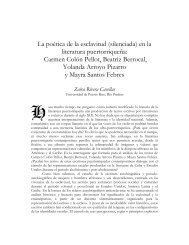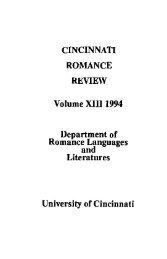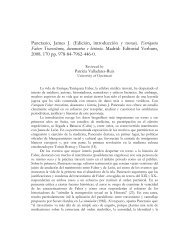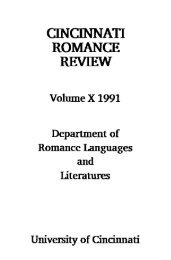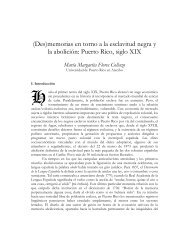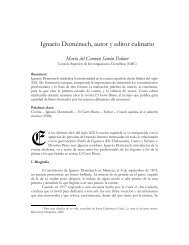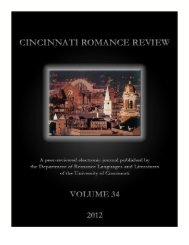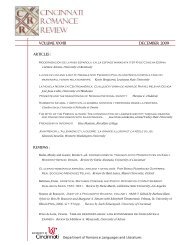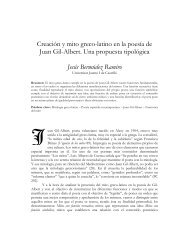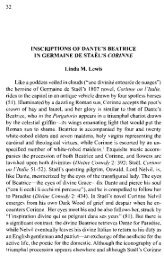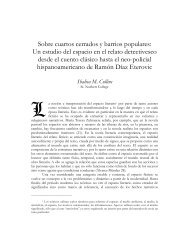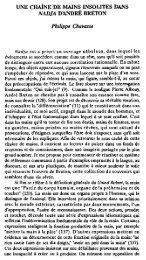Volume 30 (2011) - Cincinnati Romance Review
Volume 30 (2011) - Cincinnati Romance Review
Volume 30 (2011) - Cincinnati Romance Review
Create successful ePaper yourself
Turn your PDF publications into a flip-book with our unique Google optimized e-Paper software.
124 DOSINDA GARCÍA ALVITE<br />
and form between the theaters of Africa and Athens becomes more apparent when one<br />
considers the political, social, and religious aspects and contexts of those theaters.<br />
Greek tragedy is also a less stigmatized model, as it is both ancient and, although<br />
imported with colonialism, not originally part of the imperial cultures that colonized<br />
Africa (2).<br />
The commonalities of Antígona’s Greek tragedy with Morgades’ play are well<br />
established in the spirit of the protagonist, that of the antagonist, and the presence of<br />
themes such as individual versus state, personal conscience versus law, and divine law<br />
versus human law. The perceived cultural similarities between ancient Athens and<br />
contemporary Africa facilitate a process of transculturation that illuminates and critiques<br />
both cultures, and at the same time it allows for the introduction of cultural differences<br />
that sometimes exceed the surface similarities. While it is true that Morgades’ Antígona<br />
works as a cross-cultural, cross-temporal play because it uses material over two millenia<br />
old to address the contemporary political and social situation of Equatorial Guinea,<br />
referring to a source culture very different from the African one, it can be argued that<br />
the cultural specificities it exposes are as interesting to the current reader as its<br />
similarities. It is easy to agree that Antigone traditionally has been interpreted as a play<br />
about competing and equal laws or about a universal act of civil disobedience and see it<br />
at work in the GuineoEquatorian version (Wannamaker 73), but it is most compelling<br />
to examine how Morgades has rewritten the Antigone myth within the context of her<br />
country’s recent history and culture. Two local, specific references should be noted as<br />
advancing the principles of the protagonist within the African cultural realm: the use of<br />
drums (connected with the importance of chorus or “voces”), and the space the play<br />
provides for forces of nature to overpower human actions.<br />
The rhythm of the drums is frequently mentioned in stage directions indicating<br />
the mood that dominates each scene. For example, act one begins with focusing in the<br />
figure of Antígona whom, aware of the gravity of her role, seems to be reflecting,<br />
“Mientras cantan las voces, Antígona sigue moviéndose al ritmo de los tambores, pero<br />
parada, en actitud de escucha” (427). As a contrast, in the second act, happiness, hope<br />
and enthusiasm are expressed to announce the triumph of the president, “Tocan los<br />
tambores. Todos bailan, danza de triunfo, de entusiasmo, de grandeza, de esperanza<br />
[…] El presidente baila una danza energética de poder y de fuerza, de dominio, de<br />
soberbia, de orgullo, de satisfacción” (428). Later on, this atmosphere is radically<br />
transformed after the corruption of the president has been manifested in the deaths of<br />
many citizens, which the drums mirror with somber sounds, “Los tambores suenan<br />
invitando al sacrificio. El sonido es agudo, tétrico, cargado de misterio y de presagios”<br />
(429). And more profound still is the sound of the drums when it is intertwined with the<br />
accusations that the chorus brings forth to the president, deepening the complaints of<br />
the people “Se oye un concierto de tambores; el sonido es triste, melancólico,<br />
nostálgico, entrañable: es el lamento de la lucha de la voluntad y la inteligencia frente a<br />
las dificultades de la vida” (4<strong>30</strong>). These stage directions, with multiple references to the<br />
<strong>Cincinnati</strong> <strong>Romance</strong> <strong>Review</strong> <strong>30</strong> (Winter <strong>2011</strong>): 117-129.



